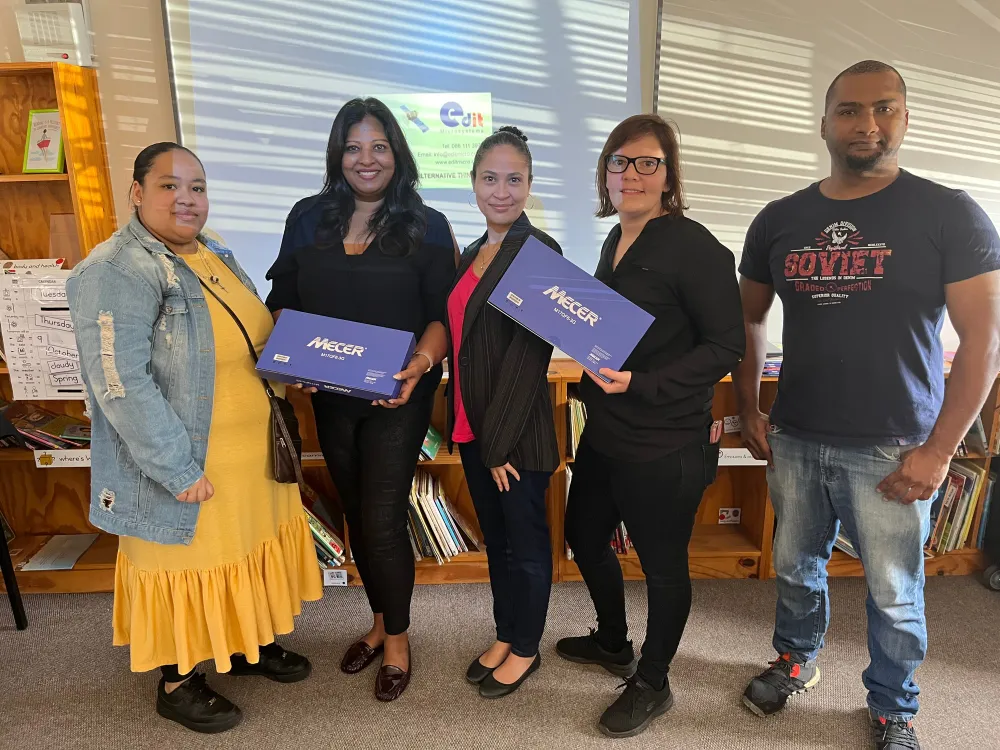Device gives pupils a voice
Conna Petersen, 6, uses a device to help communicate that she is about to cut the picture of the fish from the page.
Tears of gratitude and joy rolled down the cheeks of a mother who struggled to understand her daughter, who could not speak.
Sasha Petersen, from The Farm, whose daughter Conna, 6, is a pupil at Beacon School for Learners with Special Educational Needs (LSEN), says she was overwhelmed with emotions when the little girl started saying a few words about five months ago.
As part of celebrating Augmentative and Alternative Communication (AAC) Awareness Month in October, the school hosted a hand-over of about 20 donated devices.
AAC means all of the ways that someone communicates besides talking.
Kammy Reddy, transformation manager for Diebold Nixdorf SA, who donated the devices, said they were glad to see the children use it in all aspects of their lives, beyond the school walls.

Conna has attention-deficit/hyperactivity disorder (ADHD) and a global developmental delay, when a child takes longer to reach certain development milestones than other children their age.
Having been diagnosed about 18 months ago at Red Cross War Memorial Children’s Hospital, via a developmental doctor, Conna was able to start at the Westridge school, following applications and assessments, at the end of February.
A few weeks later as part of the school’s phase two of rolling out devices to specific pupils at schools, she received one, allowing her to participate and interact with the device as her voice.
Soon she was able to communicate via it to speak, gesture and understand what is being asked of her and reciprocate.
On Friday October 14, Ms Petersen explained the frustration of not being able to understand what her daughter wants and vice versa.
The school will now in phase three be sending devices to pupils’ homes.
These pupils were assessed and monitored to ensure they were comfortable to use a touch pad, using an application, with images, categorised in themes, to help them show, see, and hear what they need and want.

Another parent, Waseem Isaacs from Highlands Village, whose son Ilyas, 11, was introduced to using a device in class in 2019, said: “It has been life-changing”.
Before the national Covid-19 lockdown Ilyas and nine other pupils were introduced to the device at school, which formed part of the first phase.
Previously they had used flashcards and drawings to communicate with their son.
“We had so many books of flashcards that we would have to page through and cards were lying under the furniture to put together a visual aid or explanation of a task or request,” he said.
Mr Isaacs said people who cannot verbally express themselves would perhaps act out physically and violently with frustration.
His son has ADHD and is pre-verbal on the autism spectrum.
A pre-verbal child may communicate intentionally, but does not yet use words (or symbols) to communicate.
“It has been such a relief. He took to it with such ease and it gave him a voice. It has been a huge game-changer,” he said.

Deputy principal Elana le Roux said: “Just because the child can’t speak doesn’t mean they haven’t got something to say”.
She explained with the use of technology the child is able to find an image, press on the screen, which verbalises the word, they can hear it and share with their classmates and teacher.
When they do roll-call in class specific pupils who have been allocated the device use it to click on their classmates’ images – they can respond and feel at ease communicating.

Ms Le Roux said the third phase to send devices home was to allow pupils to communicate across all areas of life.